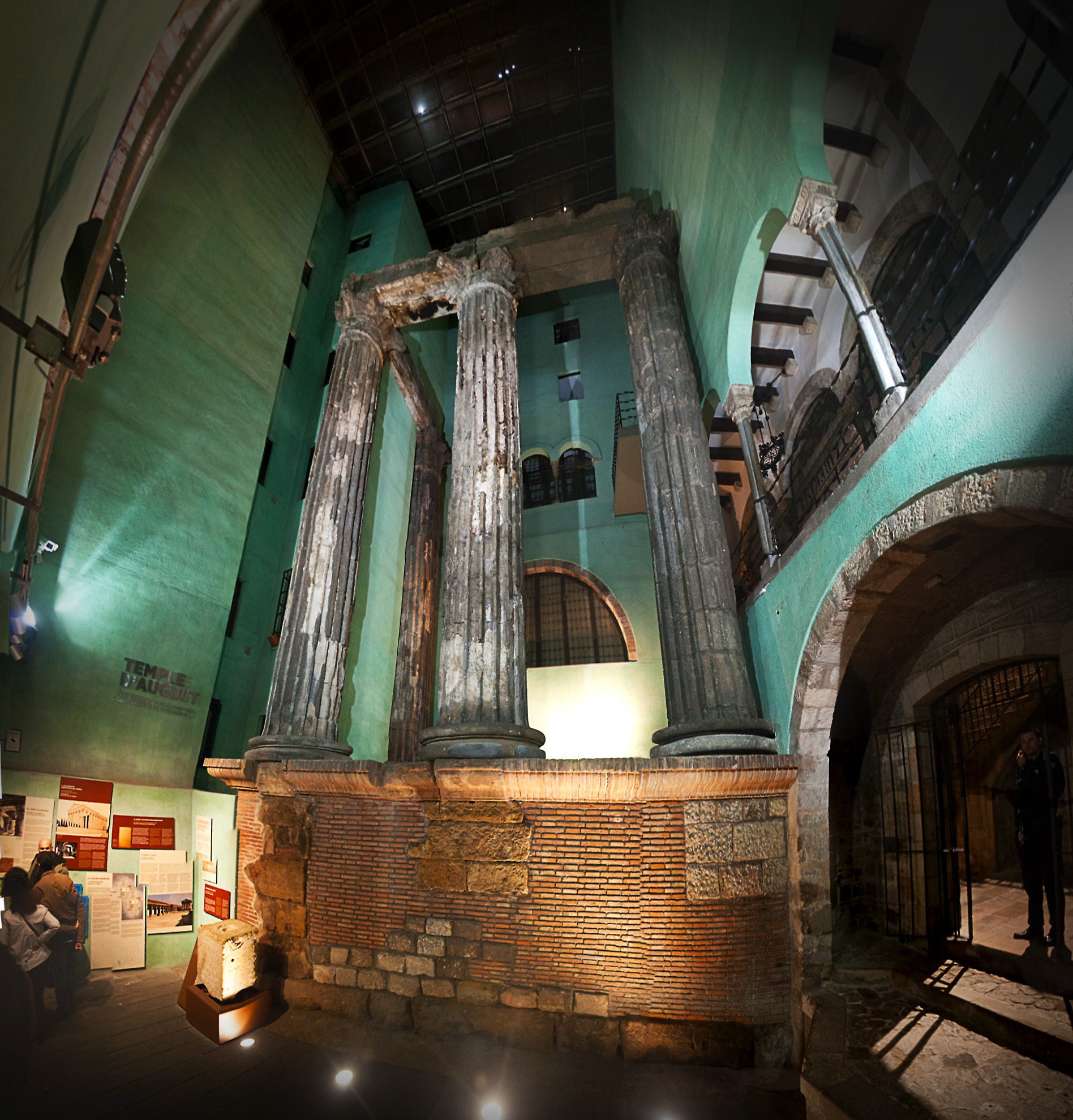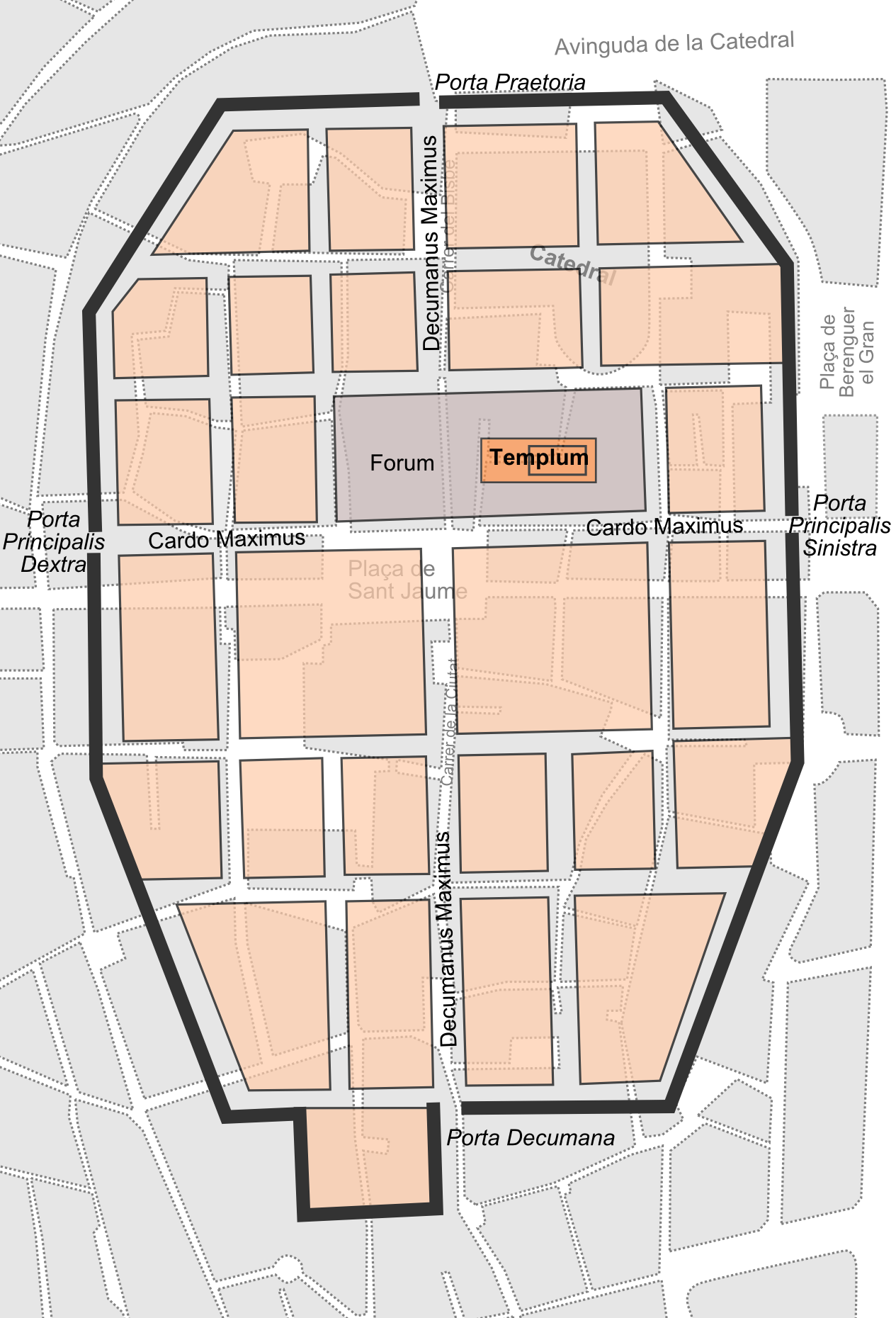|
Roman Sepulchral Way
The Sepulchral way of the Plaça de la Villa de Madrid is a Roman necropolis dating from the 1st to the 3rd century AD, located in the Plaça de la Villa de Madrid and its surroundings in Barcelona. The site lies below the current level of the square, but is visible from the street due to the urban design. It is one of the various heritage sites managed by the Museum of the History of Barcelona. Between the 1st and 3rd centuries, Roman law prohibited burials inside the city, so the necropolises of were located outside the city walls, along the roads that led out of the city. In this context, the necropolis in the Plaça de la Villa de Madrid is considered to be a secondary cemetery, far from the walls, used for the burial of the middle and lower classes, including slaves and freedmen. However, it is the best preserved and most studied necropolis of this period in Barcelona, as only scattered remains have been found in other necropolises, mostly in the form of reused funerary mon ... [...More Info...] [...Related Items...] OR: [Wikipedia] [Google] [Baidu] |
Barcelona
Barcelona ( ; ; ) is a city on the northeastern coast of Spain. It is the capital and largest city of the autonomous community of Catalonia, as well as the second-most populous municipality of Spain. With a population of 1.6 million within city limits,Barcelona: Población por municipios y sexo – Instituto Nacional de Estadística. (National Statistics Institute) its urban area extends to numerous neighbouring municipalities within the province of Barcelona and is home to around 5.3 million people, making it the fifth most populous ... [...More Info...] [...Related Items...] OR: [Wikipedia] [Google] [Baidu] |
Altar
An altar is a table or platform for the presentation of religion, religious offerings, for sacrifices, or for other ritualistic purposes. Altars are found at shrines, temples, Church (building), churches, and other places of worship. They are used particularly in Christianity, Buddhism, Hinduism, and modern paganism. Many historical-medieval faiths also made use of them, including the Religion in ancient Rome, Roman, Religion in ancient Greece, Greek, and Norse paganism, Norse religions. Etymology The modern English language, English word ''wikt:altar#English, altar'' was derived from Middle English ''wikt:alter#Latin, altar'', from Old English ''wikt:alter, alter'', taken from Latin ''wikt:altare#Latin, altare'' ("altar"), probably related to ''wikt:adolere#Etymology 2, adolere'' ("burn"); thus "burning place", influenced by ''wikt:altus#Latin, altus'' ("high"). It displaced the native Old English word ''wikt:weofod#Old English, wēofod''. Altars in antiquity In antiquity, alta ... [...More Info...] [...Related Items...] OR: [Wikipedia] [Google] [Baidu] |
Bien De Interés Cultural Landmarks In The Province Of Barcelona
Bien may refer to: * Bien (newspaper) * Basic Income Earth Network * Bień, Poland * "Bien", a song by Tini from ''Un Mechón de Pelo'' * Gertrud Bien Gertrud Bien (1881–1940) was an Austrian pediatrician and one of the first female medical students in the Austrian Empire, in Europe and globally. She was the first female medical assistant to a university professor of medicine, working with the ... (1881–1940), Austrian pediatrician * Bien-Aimé Baraza (born 1987), Kenyan musician {{disambiguation ... [...More Info...] [...Related Items...] OR: [Wikipedia] [Google] [Baidu] |
History Of Barcelona
The history of Barcelona stretches over 2000 years to its origins as an Iberian village named ''Barkeno''. Its easily defensible location on the coastal plain between the Collserola ridge (512 m) and the Mediterranean Sea, the coastal route between central Europe and the rest of the Iberian Peninsula, has ensured its continued importance, if not always preeminence, throughout the ages. Barcelona is currently a city of 1,620,943, the second largest in Spain, and the capital of the autonomous community of Catalonia. Its wider urban region is home to three-quarters of the population of Catalonia and one-eighth of that of Spain. Origins The origin of the earliest settlement at the site of present-day Barcelona is unclear. Remains from the Neolithic and early Chalcolithic periods have been found on the coastal plain near the city. The ruins of an early settlement have been excavated in the El Raval neighborhood, including different tombs and dwellings dating to earlier than 5 ... [...More Info...] [...Related Items...] OR: [Wikipedia] [Google] [Baidu] |
Serra De Collserola
The Serra de Collserola (), or simply Collserola, is a mountain range between the rivers Besòs (river), Besòs and Llobregat. It is part of the Catalan Coastal Range. These mountains separate Barcelona from the Vallès plain and their tallest peak is the Tibidabo, at 512 m. Other main summits are: Turó del Puig (Barcelona), Turó del Puig, Puig d'Olorda, Turó de Valldaura, Turó de la Magarola, Puig d'Ossa, and Puig Madrona. The valleys of the Llobregat and Besós Rivers, the plain of Barcelona, and the Vallès basin, mark the geographical boundaries of the Collserola massif. Collserola Park To preserve the area, in 1987 the Parc de Collserola (Collserola Park), which has an area of 84.65 km2, was established. It is one of the largest Parks and gardens of Barcelona, metropolitan parks in the world - 8 times larger than the Bois de Boulogne in Paris, and 22 times larger than Central Park in New York. In the park, over a thousand major plants and around thirty plant commu ... [...More Info...] [...Related Items...] OR: [Wikipedia] [Google] [Baidu] |
Alluvium
Alluvium (, ) is loose clay, silt, sand, or gravel that has been deposited by running water in a stream bed, on a floodplain, in an alluvial fan or beach, or in similar settings. Alluvium is also sometimes called alluvial deposit. Alluvium is typically geologically young and is not Consolidation (geology), consolidated into solid rock. Sediments deposited underwater, in seas, estuaries, lakes, or ponds, are not described as alluvium. Floodplain alluvium can be highly fertile, and supported some of the earliest human civilizations. Definitions The present Scientific consensus, consensus is that "alluvium" refers to loose sediments of all types deposited by running water in floodplains or in alluvial fans or related landforms. However, the meaning of the term has varied considerably since it was first defined in the French dictionary of Antoine Furetière, posthumously published in 1690. Drawing upon concepts from Roman law, Furetière defined ''alluvion'' (the French term for al ... [...More Info...] [...Related Items...] OR: [Wikipedia] [Google] [Baidu] |
Roman Walls Of Barcelona
The Roman walls of Barcelona ( Catalan and Spanish: ''Muralla romana de Barcelona'') are an archaeological and monumental complex comprising the remains of the wall built to protect Barcino—present-day Barcelona—in the time of the Roman Empire. The walls were built between the 1st century BC and the 4th century AD. They are located in the Gothic Quarter, in the Ciutat Vella district of Barcelona. The monument is listed in the register of Cultural Assets of National Interest (''Bé Cultural d'Interès Nacional'') of the Catalan government and in the register of Assets of Cultural Interest (''Bien de Interés Cultural'') of the Spanish heritage with the code RI-51-0000417. History The Roman Republic first entered the Iberian Peninsula in the course of the Second Punic War (218 BC), to counteract the power of the Carthaginians in the area, which eventually led to the conquest of the territory. This was a slow process, lasting until the year 19 BC, when the Emperor Augustus ... [...More Info...] [...Related Items...] OR: [Wikipedia] [Google] [Baidu] |
Amphora
An amphora (; ; English ) is a type of container with a pointed bottom and characteristic shape and size which fit tightly (and therefore safely) against each other in storage rooms and packages, tied together with rope and delivered by land or sea. The size and shape have been determined from at least as early as the Neolithic Period. Amphorae were used in vast numbers for the transport and storage of various products, both liquid and dry, but mostly for wine. They are most often ceramic, but examples in metals and other materials have been found. Versions of the amphorae were one of many shapes used in Ancient Greek vase painting. The amphora complements a vase, the pithos, which makes available capacities between one-half and two and one-half tons. In contrast, the amphora holds under a half-ton, typically less than . The bodies of the two types have similar shapes. Where the pithos may have multiple small loops or lugs for fastening a rope harness, the amphora has two expa ... [...More Info...] [...Related Items...] OR: [Wikipedia] [Google] [Baidu] |
Stele
A stele ( ) or stela ( )The plural in English is sometimes stelai ( ) based on direct transliteration of the Greek, sometimes stelae or stelæ ( ) based on the inflection of Greek nouns in Latin, and sometimes anglicized to steles ( ) or stelas ( ). is a stone or wooden slab, generally taller than it is wide, erected in the ancient world as a monument. The surface of the stele often has text, ornamentation, or both. These may be inscribed, carved in relief, or painted. Stelae were created for many reasons. Grave stelae were used for funerary or commemorative purposes. Stelae as slabs of stone would also be used as ancient Greek and Roman government notices or as boundary markers to mark borders or property lines. Stelae were occasionally erected as memorials to battles. For example, along with other memorials, there are more than half-a-dozen steles erected on the battlefield of Waterloo at the locations of notable actions by participants in battle. A traditional Wester ... [...More Info...] [...Related Items...] OR: [Wikipedia] [Google] [Baidu] |
Sarrià, Barcelona
Sarrià () is a neighborhood in the ''Sarrià-Sant Gervasi'' district of Barcelona, Catalonia, Spain. Its main street is Major de Sarrià. Former municipality Today what was the old municipality is divided into various neighborhoods and districts. Most are in the district of Sarrià-Sant Gervasi, the neighborhoods of Sarrià and les Tres Torres, two small areas in the neighborhoods of Sant Gervasi - la Bonanova and Sant Gervasi - Galvany. Vallvidrera independent town but was added to Sarrià in the 1890. The neighborhood of Pedralbes was also part of the old town before local boundaries were redrawn in 1984, but is currently included in the district of les Corts. Communications In 1858 Sarrià was connected to Barcelona Barcelona ( ; ; ) is a city on the northeastern coast of Spain. It is the capital and largest city of the autonomous community of Catalonia, as well as the second-most populous municipality of Spain. With a population of 1.6 million within c ... b ... [...More Info...] [...Related Items...] OR: [Wikipedia] [Google] [Baidu] |
Catalonia
Catalonia is an autonomous community of Spain, designated as a ''nationalities and regions of Spain, nationality'' by its Statute of Autonomy of Catalonia of 2006, Statute of Autonomy. Most of its territory (except the Val d'Aran) is situated on the northeast of the Iberian Peninsula, to the south of the Pyrenees mountain range. Catalonia is administratively divided into four Provinces of Spain, provinces or eight Vegueries of Catalonia, ''vegueries'' (regions), which are in turn divided into 43 Comarques of Catalonia, ''comarques''. The capital and largest city, Barcelona, is the second-most populous Municipalities in Spain, municipality in Spain and the fifth-most populous List of metropolitan areas in Europe, urban area in the European Union. > > > ''Catalonia'' theoretically derived. During the Middle Ages, Byzantine Empire, Byzantine chroniclers claimed that ''Catalania'' derives from the local medley of Goths with Alans, initially constituting a ''Goth-Alania''. Othe ... [...More Info...] [...Related Items...] OR: [Wikipedia] [Google] [Baidu] |







